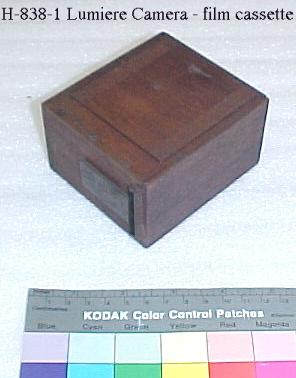Lumiere Movie Camera and Projector - film cassette
Production date
Circa 1898
Country
France
State/Province
Ile-de-France
See full details
Object detail
Description
Film cassette, consist of a wooden box with sliding door. Inside is a metal plate with 2 upright posts, one of which is anchored to the base, allowing pivotal movement. Small spring attached in one corner. Six small screws used in construction - flat brass pate screwed to one end on the outside.
Classification
PHOTOGRAPHY Cameras Cine cinematographe
Maker
Production date
Circa 1898
Production place
Measurements
L95 x W85 x H55
Media/Materials description
Indeterminate (Woods)
Brass (Metals - Non-Ferrous)
Brass (Metals - Non-Ferrous)
History and use
The Lumiere Cinematographe, invented in France in1894, was a portable projector, camera, and film processor in one. It was invented by Auguste and Louis Lumiere - brothers, whose designs strongly shaped the future and popularity of modern cinema.
This film cassette was used to store film safely away from exposure to light.
There are only 12 known examples of the Cinematographe in the world today. Three are in Australia, of which this is the only one still in operating condition. It was acquired by the Queensland Department of Agriculture and Stock in 1899 and was used by the Department's artist and photographer Frederick Charles Wills and his assistant Henry William Mobsby. Together they comprised the worlds first government-funded film unit.
Footage filmed by this Cinematographe and possibly stored in this cassette includes scenes of the opening of Queensland parliament, sugar mills in Nambour, and Boer War soldiers marching on Queen Street, Brisbane. The 43 surviving reels of film Wills and Mobsby took comprise the largest collection of Australian film still in existence.
This film cassette was used to store film safely away from exposure to light.
There are only 12 known examples of the Cinematographe in the world today. Three are in Australia, of which this is the only one still in operating condition. It was acquired by the Queensland Department of Agriculture and Stock in 1899 and was used by the Department's artist and photographer Frederick Charles Wills and his assistant Henry William Mobsby. Together they comprised the worlds first government-funded film unit.
Footage filmed by this Cinematographe and possibly stored in this cassette includes scenes of the opening of Queensland parliament, sugar mills in Nambour, and Boer War soldiers marching on Queen Street, Brisbane. The 43 surviving reels of film Wills and Mobsby took comprise the largest collection of Australian film still in existence.
Registration number
H838.1



